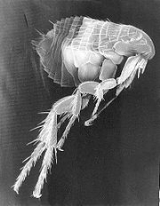
Rat flea
Overview
The Oriental rat flea also known as the tropical rat flea, is a parasite of rodents, primarily of the genus Rattus, and is a primary vector for bubonic plague
and murine typhus
. This occurs when the flea has fed on an infected rodent, and then bites a human. The oriental rat flea is most infamous for contributing to the Black Death
.
The Oriental rat flea has no genal or pronotal combs. This characteristic can be used to differentiate the oriental rat flea from the cat flea
, dog flea
, and other flea
s.
The flea's body is only about one tenth of an inch long (about 0.1 inches (2.5 mm)).
Bubonic plague
Plague is a deadly infectious disease that is caused by the enterobacteria Yersinia pestis, named after the French-Swiss bacteriologist Alexandre Yersin. Primarily carried by rodents and spread to humans via fleas, the disease is notorious throughout history, due to the unrivaled scale of death...
and murine typhus
Murine typhus
Murine typhus is a form of typhus transmitted by fleas , usually on rats. Murine typhus is an under-recognized entity, as it is often confused with viral illnesses...
. This occurs when the flea has fed on an infected rodent, and then bites a human. The oriental rat flea is most infamous for contributing to the Black Death
Black Death
The Black Death was one of the most devastating pandemics in human history, peaking in Europe between 1348 and 1350. Of several competing theories, the dominant explanation for the Black Death is the plague theory, which attributes the outbreak to the bacterium Yersinia pestis. Thought to have...
.
The Oriental rat flea has no genal or pronotal combs. This characteristic can be used to differentiate the oriental rat flea from the cat flea
Cat flea
The cat flea, Ctenocephalides felis, is one of the most abundant and widespread species of flea on Earth.-Overview:The cat flea's primary host is the domestic cat, but this is also the primary flea infesting dogs in most of the world. The cat flea can also maintain its life cycle on other...
, dog flea
Dog flea
The dog flea is a species of flea that lives primarily on the blood of dogs. The dog flea is troublesome because it can spread Dipylidium caninum. They are commonly found in Europe....
, and other flea
Flea
Flea is the common name for insects of the order Siphonaptera which are wingless insects with mouthparts adapted for piercing skin and sucking blood...
s.
The flea's body is only about one tenth of an inch long (about 0.1 inches (2.5 mm)).

